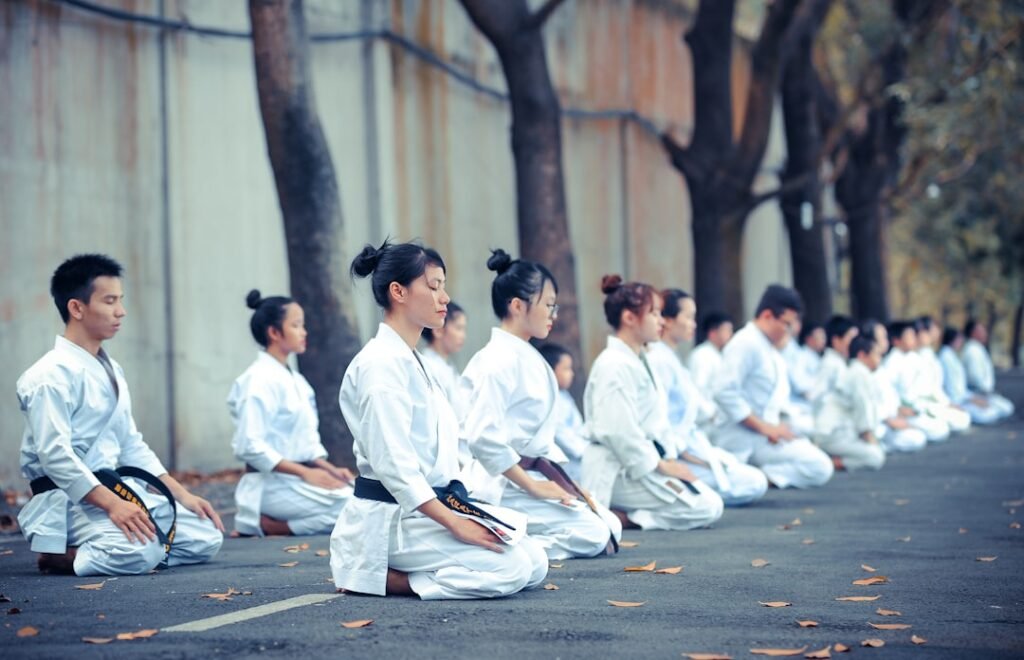Tai Chi, an ancient Chinese martial art, is not merely a physical practice; it embodies a rich tapestry of philosophy, culture, and language. The movements of Tai Chi are often accompanied by specific terminology that is deeply rooted in the Chinese language. Understanding these terms can significantly enhance a practitioner’s experience, allowing them to connect more profoundly with the art form.
For instance, concepts such as “Qi” (energy) and “Yin-Yang” (the duality of nature) are integral to Tai Chi and are best appreciated through their original linguistic context. This connection between language and practice creates a holistic approach to learning that transcends mere physicality. Moreover, the language of Tai Chi is steeped in the cultural nuances of China.
Each movement, posture, and principle is often described using specific Chinese characters that convey deeper meanings. For example, the term “Tui Shou” refers to “push hands,” a fundamental exercise in Tai Chi that emphasises sensitivity and connection with a partner. By learning the Chinese language, practitioners can gain insights into the philosophical underpinnings of these movements, enriching their practice and fostering a greater appreciation for the art form. Spaces are filling up fast! Register for Chinese classes at the LC Chinese School in Oslo today.
Table of Contents
ToggleSummary
- The connection between Tai Chi and Chinese language is deeply rooted in the cultural and philosophical principles of Tai Chi, making it beneficial for practitioners to understand Chinese language.
- Understanding the cultural context of Tai Chi and Chinese language is essential for practitioners to fully grasp the principles and history of Tai Chi.
- Learning Chinese can benefit Tai Chi practitioners by providing access to a wealth of resources, including ancient texts and teachings, that can enhance their practice.
- Finding the right Chinese language resources in Oslo is crucial for Tai Chi practitioners, as it can help them immerse themselves in the language and culture.
- Incorporating Chinese language learning into your Tai Chi practice can deepen your understanding of the principles and philosophy behind the martial art.
Understanding the Cultural Context of Tai Chi and Chinese Language
To fully grasp the essence of Tai Chi, one must delve into its cultural context, which is intricately linked to the Chinese language. Tai Chi originated as a form of self-defence but evolved into a practice that promotes health, balance, and mindfulness. The philosophical principles that underpin Tai Chi are deeply embedded in Chinese culture, drawing from Confucianism, Taoism, and Buddhism.
These philosophies are articulated through the language, making it essential for practitioners to understand the cultural backdrop against which Tai Chi was developed. The Chinese language itself is a reflection of this rich cultural heritage. Its characters often carry multiple meanings and connotations, which can illuminate the subtleties of Tai Chi practice.
For instance, the character for “Tai” (太) signifies “great” or “supreme,” while “Chi” (极) denotes “ultimate” or “extreme.” Together, they encapsulate the idea of achieving a state of balance and harmony. By learning the language, practitioners can engage more deeply with these concepts, fostering a more profound connection to their Tai Chi practice.
Benefits of Learning Chinese for Tai Chi Practitioners

Learning Chinese offers numerous benefits for Tai Chi practitioners, enhancing both their understanding and execution of the art. Firstly, it allows for direct engagement with traditional texts and teachings that may not be adequately translated into other languages. Many classical Tai Chi manuals are written in Chinese, containing invaluable insights into techniques, philosophy, and history.
By studying these texts in their original language, practitioners can access a wealth of knowledge that might otherwise remain obscured by translation. Additionally, proficiency in Chinese can facilitate communication with instructors and fellow practitioners from China or those who speak Mandarin. This opens up opportunities for deeper learning experiences, such as attending workshops or seminars led by renowned masters.
Engaging with native speakers can also provide practical insights into the subtleties of Tai Chi movements and principles that may not be conveyed through English explanations alone.
Finding the Right Chinese Language Resources in Oslo
For those residing in Oslo and eager to learn Chinese alongside their Tai Chi practice, there are several resources available to facilitate this journey. The LC Chinese School stands out as a premier institution offering comprehensive Chinese language courses tailored to various proficiency levels. With experienced instructors who understand the unique needs of Tai Chi practitioners, students can expect a curriculum that integrates language learning with cultural insights relevant to their practice.
In addition to formal classes at LC Chinese School, there are also community resources such as language exchange groups and cultural events that provide opportunities for immersive learning. Engaging with local Chinese-speaking communities can enhance language skills while fostering connections with individuals who share a passion for Tai Chi. By exploring these resources, practitioners can create a well-rounded approach to learning both the language and the art.
Incorporating Chinese Language Learning into Your Tai Chi Practice
Integrating Chinese language learning into Tai Chi practice can be both enjoyable and beneficial. One effective method is to label movements and postures in Chinese during training sessions. For instance, as practitioners perform “Wu Ji” (the starting position), they can repeat the term aloud, reinforcing their memory of the movement while simultaneously learning its name in Chinese.
This method not only aids in memorisation but also helps to create a more immersive environment where language and practice coexist harmoniously. Another approach is to incorporate vocabulary related to Tai Chi principles into daily practice routines. Practitioners can set aside time each week to focus on specific terms or phrases that resonate with their training goals.
For example, understanding terms like “Jin” (force) or “Song” (relaxation) can deepen one’s comprehension of the physical sensations experienced during practice. By consciously linking language learning with physical movements, practitioners can cultivate a more integrated understanding of both aspects.
Practical Tips for Learning Chinese as a Tai Chi Practitioner

Learning Chinese as a Tai Chi practitioner requires dedication and strategic planning. One practical tip is to establish a consistent study routine that aligns with your Tai Chi practice schedule. Setting aside specific times each week for language study can help create a sense of discipline and progress.
Additionally, utilising various learning methods—such as flashcards for vocabulary, audio resources for pronunciation, and writing exercises for character recognition—can cater to different learning styles. Engaging with multimedia resources can also enhance the learning experience. Watching videos or listening to podcasts that discuss Tai Chi in Chinese can provide context for vocabulary while exposing learners to native pronunciation and intonation.
Furthermore, joining online forums or social media groups focused on Tai Chi can offer opportunities for interaction with other learners and native speakers alike, fostering a sense of community and support.
Using Chinese Language to Deepen Your Understanding of Tai Chi Principles
The principles of Tai Chi are often encapsulated in specific terminology that carries profound meaning within the context of Chinese philosophy. By learning these terms in their original language, practitioners can gain insights that may be lost in translation. For instance, understanding the concept of “Zhong Ding” (central equilibrium) not only informs physical balance but also encourages mental stability—a core tenet of Tai Chi practice.
Moreover, exploring the etymology of key terms can reveal layers of meaning that enrich one’s understanding of Tai Chi principles. For example, the character for “Li” (力), meaning strength or power, is composed of elements that signify both physical force and inner strength. This duality reflects the essence of Tai Chi as a practice that harmonises external movements with internal energy cultivation.
By delving into these linguistic nuances, practitioners can cultivate a more profound appreciation for the art form.
Building Relationships with Chinese Speakers in the Oslo Tai Chi Community
Building relationships with Chinese speakers within the Oslo Tai Chi community can significantly enhance both language skills and cultural understanding. Engaging with native speakers provides opportunities for authentic conversations that reinforce language learning while fostering connections based on shared interests. Participating in local Tai Chi classes or workshops led by Chinese instructors can create an environment conducive to meaningful interactions.
Additionally, attending cultural events or festivals celebrating Chinese traditions can further immerse practitioners in the language and culture associated with Tai Chi. These gatherings often feature performances, demonstrations, and discussions that highlight the significance of Tai Chi within broader cultural contexts. By actively participating in such events, practitioners can forge friendships while simultaneously enhancing their language proficiency.
Exploring Chinese Language and Tai Chi in Oslo’s Cultural Scene
Oslo’s cultural scene offers numerous avenues for exploring the intersection of Chinese language and Tai Chi. The city hosts various cultural events throughout the year that celebrate Chinese heritage, including festivals showcasing traditional music, dance, and martial arts demonstrations. These events provide an excellent opportunity for practitioners to witness Tai Chi performed by skilled artists while engaging with the language used to describe these practices.
Furthermore, local museums and cultural centres often feature exhibitions related to Chinese history and philosophy, offering insights into the cultural context from which Tai Chi emerged. Attending lectures or workshops at these venues can deepen one’s understanding of both the art form and its linguistic roots. By actively participating in Oslo’s cultural landscape, practitioners can enrich their journey towards mastering both Tai Chi and the Chinese language.
Overcoming Language Barriers in Tai Chi Training and Practice
Language barriers can pose challenges for those seeking to deepen their understanding of Tai Chi through communication with instructors or fellow practitioners who speak Mandarin. However, these barriers can be overcome through proactive strategies such as using visual aids during training sessions or employing translation apps when necessary. Many instructors are accustomed to working with non-native speakers and may offer alternative explanations or demonstrations to facilitate understanding.
Additionally, cultivating patience and openness towards learning can help alleviate frustrations associated with language barriers. Embracing mistakes as part of the learning process fosters resilience and encourages continued engagement with both the language and the art form. By approaching challenges with a positive mindset, practitioners can navigate linguistic obstacles while remaining committed to their Tai Chi journey.
Taking Your Tai Chi Practice to the Next Level with Chinese Language Proficiency
Achieving proficiency in the Chinese language can elevate one’s Tai Chi practice to new heights. With an understanding of key terminology and concepts rooted in the language, practitioners can engage more deeply with their training while gaining access to traditional teachings that inform their practice. This linguistic proficiency not only enhances physical execution but also fosters a greater appreciation for the philosophical underpinnings of Tai Chi.
At LC Chinese School in Oslo, dedicated courses tailored specifically for those interested in integrating language learning with their martial arts journey are available. These courses provide an excellent opportunity for practitioners to develop their skills while connecting with like-minded individuals who share a passion for both Tai Chi and the Chinese language. By taking advantage of these resources, practitioners can embark on a transformative journey that enriches their understanding of this ancient art form while cultivating meaningful connections within their community.
In conclusion, the interplay between Tai Chi and the Chinese language offers a unique pathway for practitioners seeking to deepen their understanding of this ancient art form. By embracing both aspects—language learning and physical practice—individuals can cultivate a holistic approach that enhances their experience on multiple levels. Whether through formal education at institutions like LC Chinese School or engaging with local communities in Oslo, there are abundant opportunities for growth and connection within this vibrant cultural landscape.







